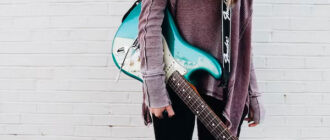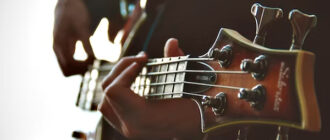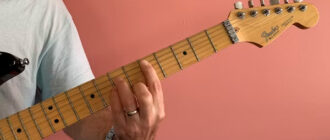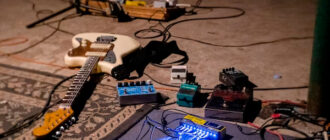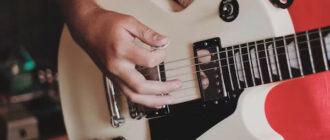
How to Place Capo on Your Guitar: A Beginner’s Guide Are you a novice guitarist looking to master the art of using a capo on your guitar neck? In this comprehensive guide, we’ll take you through the step-by-step process of placing a capo, explore various types, and provide crucial tips for using it on acoustic or other guitars. Don’t forget to check out a capo chart online to enhance your understanding of chord shapes in different keys. Dive into the world of capo usage with this beginner-friendly article!
Table of Contents
Is There a Correct Way to Put on a Capo?
Yes, there is a correct way to put on a capo to change the key of a song. The capo should be placed directly behind the desired fret, not on top of it or in-between frets. Make sure the capo is pressing down on all strings and is not touching any fret wires to avoid any buzzing or unwanted noise. That way you can move the capo freely, but the capo in place also presses on all strings. Be careful with the fret and play cautiously at first. The capo will make playing a guitar a new experience.
How to place capo?
Using a capo is relatively simple and can open up a whole new world of chord voicings and keys without having to learn new chord shapes because you can just change the capo position. Here are the 3 easy steps to place a capo on your guitar without having to ask a guitar instructor.
1. Choose the desired fret where you want to raise the pitch of your guitar. The capo should be placed just behind the desired fret, not on the fret itself, for example a capo on the third fret will still be behind it. And moving capo to the second fret will place it behind the second fret.
2. Attach the capo to the neck of your guitar by pressing down on the strings of your guitar and securing it in place. Use your capo with reasonable force.
3. Make sure the capo is in place and apply the right amount of pressure across all the strings of your guitar. A trigger capo is a great choice for first-time users. For more advanced players, a partial capo is a good way to diversify playing, so that even a standard C chord sounds different.
Types of Capos

Image by Daniel Prado from Unplash
Capos come in handy for guitar players who want to play songs in a different key without having to learn new chords. There are several types of capos available, including screw capos, spring-loaded trigger capos, partial capos, and cradle capos. Those types of capo up to the fifth fret will change the chords significantly.
Screw capos are the most common type of capo and are basically a clamp that is tightened or loosened to the desired amount of pressure across the strings. Spring-loaded trigger capos are easier to use and can be quickly attached or removed from the neck of your guitar. Partial capos are designed to only cover a few strings, allowing for different chord voicings in the same key.
Cradle capos are similar to spring-loaded trigger capos but are designed to fit the neck of your guitar more snugly, so when you attach a capo, it will not fall off even if you are running and jumping with the guitar. Choose what capo is right for you and for the particular fret where you always put it.
How to Put a Screw Capo on a Guitar?
A screw capo is one of the most common types of capos and is relatively simple to use. First, make sure your guitar is in tune. Then, place the capo on the desired fret and tighten the screw until the capo is securely in place. Make sure the capo is pressing down on all strings and is not touching any fret wires. You can easily change keys with a capo attached the right way.
How to Put a Cradle Capo on a Guitar?
A cradle capo, also known as a spring-loaded capo, is another popular type of capo. To use a cradle capo, simply place it on the desired fret and press down on the lever until it clicks into place. Make sure all strings are being pressed down evenly and are not touching any fret wires.
Where Do You Put the Capo on the First Fret?
To place the capo on the first fret, simply position it directly behind the first fret and make sure it’s pressing down on all strings. Capo is a small tool that changes the tune greatly and can help find a new key for your songs. It allows you to play without retuning the strings back and forth.
Where Do I Put the Capo for Key of C?
If you’re playing in the key of C, you can place the capo on the first fret to play in the key of C# or on the second fret to play in the key of D.
Understanding How to Use a Capo

Image by Tyler Clemmensen from Unplash
The position of the capo will allow you to play the song in a different key. For example, if you place the capo on the first fret of your guitar, you will be able to play in the key of F instead of E. If you place the capo on the second fret, you will be able to play in the key of F# instead of E. A capo raises the key by raising the pitch of the strings by a specific number of semitones, depending on the placement of the capo. That’s how the capo works. Put the capo properly on and enjoy the new sound.
Using a capo can be a great tool for beginner guitarists who are still learning how to play the guitar. It allows you to experiment with different sounds and play in a higher key without having to learn new chords.
Tips and Warnings
Here are some essential tips and warnings to keep in mind when using a capo:
· Try to place your capo as close to the desired fret as possible to avoid any buzzing or unwanted sounds. Open chord shapes will be easier with a right capo.
· Experiment with different positions of the capo to find the right sound for the particular song you’re playing. One of the main reasons why guitarists choose capo is experimentation.
· Make sure not to apply too much pressure across the strings, as this can cause your guitar to go out of tune. Look into Shubb capos, it is a trusted company.
· Always remove the capo when you’re done playing to avoid any damage to your guitar’s neck. Capos allow for a unique sound, but you should not overuse them. Sometimes if you need to go a half-step higher, you can just use your fingers.
In conclusion, using a capo on your guitar is a relatively simple process that can open up a whole new world of possibilities for your playing. Whether you’re a beginner or an experienced guitarist, a capo can be a useful tool to help you play songs in different keys and experiment with different sounds. Hope you don’t need any other Q&A. So, go ahead and try out using a capo for beginners in your guitar lessons and see the difference it makes in your playing!

